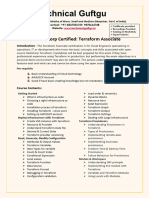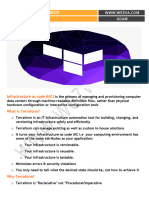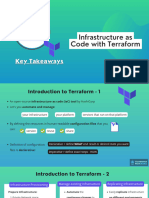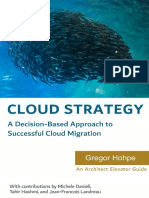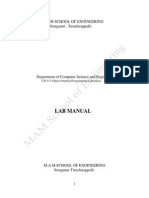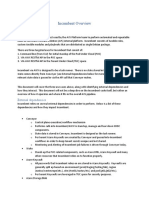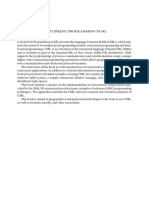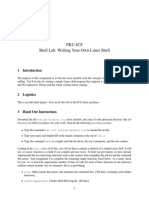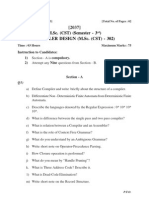Terraform Basics To Advanced in One Guide - v1.2
Uploaded by
pradyaimlTerraform Basics To Advanced in One Guide - v1.2
Uploaded by
pradyaimlTERRAFORM BASICS
TO ADVANCED
IN ONE GUIDE
Your complete journey from
novice to expert in IaC
Govardhana Miriyala Kannaiah
2
I'm Govardhana Miriyala Kannaiah, a DevOps
and Multi-Cloud Architect with over 17 years
of IT experience.
Over the past year, I’ve built a LinkedIn
community of 88k+ followers and launched
NeuVeu, a consulting firm that has served
16+ clients—from enterprises like Hearst and
Stanford University to small-scale companies
like MapDigital.
I’ve noticed that while many see Terraform’s
potential, they often miss out on its full
capabilities.
This Terraform Basics to Advanced in One
Guide takes you from essentials to advanced
practices, helping you build the skills needed
to unlock Terraform’s power for scalable,
reliable infrastructure.
https://www.techopsexamples.com/
Copyright 2025 TechOpsExamples techopsexamples.com
Terraform Basics to Advanced in One Guide 3
Table of Contents
Introduction 4
Target Audience 4
Resources 4
Terraform Fundamentals 5
Setting Up Your Terraform Environment 11
Core Terraform Workflow 19
Managing Infrastructure with Terraform 28
Variables, Data Types, and Outputs 37
Advanced Terraform Techniques 44
Provisioners and Lifecycle Management 51
Debugging and Troubleshooting 61
Must Know Commands 68
Copyright 2024 TechOpsExamples techopsexamples.com
Terraform Basics to Advanced in One Guide 4
Introduction
This guide is designed to provide the essentials needed to
master Terraform, creating a strong foundation for
effective infrastructure management. Whether you’re just
starting out or aiming to advance your skills, this guide
offers a clear and structured path to set you up for long-
term success
Target Audience
This guide is for:
Beginners who want to understand the needed
fundamentals before getting into advanced IaC.
Experienced individuals looking to improve their
skills and fill any gaps in their knowledge.
Resources
To discover real-world use cases, tech updates, and
learning resources, check out:
Full Editions: https://www.techopsexamples.com/
Copyright 2025 TechOpsExamples techopsexamples.com
Terraform Basics to Advanced in One Guide 5
1. Terraform Fundamentals
Terraform is a powerful Infrastructure as Code (IaC) tool
that enables you to define and provision data center
infrastructure using a declarative configuration language.
Understanding its core concepts is essential to efficiently
manage scalable infrastructure.
Key Concepts:
Terraform vs. Other IaC Tools
Declarative vs. Imperative Approach
High-Level Architecture
Copyright 2025 TechOpsExamples techopsexamples.com
Terraform Basics to Advanced in One Guide 6
Terraform vs. Other IaC Tools
Terraform is a leader among Infrastructure-as-Code (IaC)
tools, known for its declarative syntax, provider-agnostic
design, and robust ecosystem.
While tools like Pulumi offer flexibility with programming
languages, or frameworks like OpenTofu (formerly
OpenTF) provide open-source alternatives, Terraform’s
established ecosystem make it a go-to choice for many
DevOps teams.
Key highlights include:
Multi-Cloud Support: Terraform can manage
resources on AWS, Azure, Google Cloud,
Kubernetes, GitHub, Datadog, and more.
State Management: Terraform uses a state file to
track resource mappings, enabling features like
change previews and dependency handling.
Community Ecosystem: The Terraform Registry and
open-source modules accelerate adoption by offering
pre-built configurations for common scenarios.
Copyright 2025 TechOpsExamples techopsexamples.com
Terraform Basics to Advanced in One Guide 7
The decision tree below will be handy for arriving at the
right choice based on the use case.
Copyright 2025 TechOpsExamples techopsexamples.com
Terraform Basics to Advanced in One Guide 8
Declarative vs. Imperative Approach
One of Terraform’s defining features is its declarative
approach.
Instead of instructing how to achieve a state (imperative),
you declare what the desired state of your infrastructure
should look like, and Terraform ensures it happens.
Approach Characteristics Example
Focus on the
resource
desired state;
Declarative "aws_s3_bucket"
automation
"my_bucket" { ... }
handles the 'how'.
Focus on the steps aws s3api create-
Imperative needed to achieve bucket --bucket my-
the state. bucket
Declarative tools like Terraform simplify managing
complex dependencies and ensure idempotency
(repeating actions yields the same result).
Imperative tools, though flexible, demand more
control and scripting knowledge.
Copyright 2025 TechOpsExamples techopsexamples.com
Terraform Basics to Advanced in One Guide 9
High-Level Architecture
Though we discuss in detail each of the listed components,
in simple terms, if I explain the Terraform architecture:
Terraform works by connecting your infrastructure code to
the actual cloud resources you want to provision.
Its architecture consists of two main parts:
1. Terraform Manifest Files:
These are .tf files where you define the infrastructure's
desired state. Common files include:
providers.tf: Declares the cloud providers (e.g., AWS,
GCP).
main.tf: Specifies the resources (e.g., virtual
machines, databases).
Copyright 2025 TechOpsExamples techopsexamples.com
Terraform Basics to Advanced in One Guide 10
variables.tf: Defines reusable inputs for configuration.
backend.tf: Configures where the Terraform state is
stored.
outputs.tf: Captures outputs, like resource IDs or IPs,
after provisioning.
2. Terraform Core:
The core processes the .tf files, plans the changes, and
ensures the current state matches the desired state.
It manages the state file, which tracks your
infrastructure's current configuration.
Providers: Enable Terraform to interact with cloud
APIs like AWS, Azure, and Kubernetes.
Provisioners: Handle post-deployment tasks (e.g.,
running scripts or transferring files).
Copyright 2025 TechOpsExamples techopsexamples.com
Terraform Basics to Advanced in One Guide 11
2. Setting Up Your Terraform
Environment
To start using Terraform, you need to install it, configure it
to connect to your infrastructure, and understand how it
tracks and manages your resources. This chapter will
walk you through these steps in a clear and structured
way.
Key Concepts:
Terraform Installation
Configuring Providers
Understanding Terraform State
Configuring Backends for State Storage
Copyright 2025 TechOpsExamples techopsexamples.com
Terraform Basics to Advanced in One Guide 12
Terraform Installation
Terraform is a single, lightweight executable file that
works on Windows, Linux, and macOS. Follow the steps
for your operating system below to get it installed and
ready.
Step by Step Installation Instructions
Configuring Providers
Terraform uses providers to communicate with the
infrastructure you want to manage. Providers are plugins
that allow Terraform to work with specific services like
AWS, Azure, Google Cloud, or even on-premises
platforms like VMware.
Providers are hosted on the Terraform Registry, where
you’ll find documentation, versions, and usage examples.
Copyright 2025 TechOpsExamples techopsexamples.com
Terraform Basics to Advanced in One Guide 13
Which categorizes them as:
Official: Maintained by HashiCorp.
Verified: Maintained by trusted third-party technology
vendors.
Community: Published by Terraform users or groups.
How Providers Work ?
1. Declare Providers
Providers are defined using the provider block, which tells
Terraform which API or service to interact with.
2. Download Providers
The terraform init command downloads the specified
providers from the Terraform Registry (or a local mirror)
into the .terraform directory.
3. Provider Caching
Use plugin_cache_dir to enable caching, speeding up
provider downloads and enabling offline workflows.
Sample gcp provider.tf
provider "google" {
project = "my-gcp-project"
region = "us-central1"
}
Copyright 2025 TechOpsExamples techopsexamples.com
Terraform Basics to Advanced in One Guide 14
Provider Meta-Arguments
Alias: Use the same provider with different
configurations (e.g., multiple accounts, regions).
Default Provider: If no alias is specified, it is the
default configuration.
Example: Using Aliases with Google Cloud:
provider "google" {
project = "default-project"
region = "us-central1"
}
provider "google" {
alias = "secondary"
project = "secondary-project"
region = "us-east1"
}
resource "google_storage_bucket"
"secondary_bucket" {
provider = google.secondary
name = "my-secondary-bucket"
}
Copyright 2025 TechOpsExamples techopsexamples.com
Terraform Basics to Advanced in One Guide 15
Use required_providers to specify source and version.
terraform {
required_providers {
google = {
source = "hashicorp/google"
version = "~> 5.0"
}
}
}
provider "google" {
project = "my-gcp-project"
region = "us-central1"
}
Understanding Terraform State
Terraform state is a file that keeps track of all the
resources Terraform creates and manages. It acts as the
"source of truth" for Terraform.
Copyright 2025 TechOpsExamples techopsexamples.com
Terraform Basics to Advanced in One Guide 16
Local State vs. Remote State
Local State Remote State
Stored in a local file Stored in remote storage (e.g.,
(terraform.tfstate) S3, Azure Blob).
Suitable for single users Suitable for teams and
or testing. production.
Risk of data loss if file is Centralized, secure, and
deleted. versioned.
State locking prevents multiple users from updating the
same state file at the same time, avoiding corruption.
Best Practices:
Use remote backends for state storage.
Enable state locking using S3 (for AWS) or equivalent
solutions.
Regularly back up your state file.
Configuring Backends for State Storage
A backend defines where Terraform stores its state.
Remote backends are highly recommended for teams and
production environments.
Copyright 2025 TechOpsExamples techopsexamples.com
Terraform Basics to Advanced in One Guide 17
S3 Backend for AWS
Using S3 for state storage and locking:
terraform {
backend "s3" {
bucket = "my-terraform-state"
key = "prod/terraform.tfstate"
region = "us-east-1"
use_lockfile = true
encrypt = true
}
}
Azure Blob Storage Backend
terraform {
backend "azurerm" {
resource_group_name = "my-rg"
storage_account_name = "mystorageaccount"
container_name = "tfstate"
key =
"prod.terraform.tfstate"
}
}
Copyright 2025 TechOpsExamples techopsexamples.com
Terraform Basics to Advanced in One Guide 18
GCS Backend for Google Cloud
terraform {
backend "gcs" {
bucket = "my-tf-state-bucket"
prefix = "prod/state"
}
}
Copyright 2025 TechOpsExamples techopsexamples.com
Terraform Basics to Advanced in One Guide 19
3. Core Terraform Workflow
The Terraform workflow consists of a series of steps to
initialize, write, validate, plan, apply, and destroy
infrastructure. These steps form a repeatable process to
manage infrastructure safely and predictably.
Key Concepts:
Initialization (`terraform init`)
Writing and Organizing Terraform Configurations
Planning Changes (`terraform plan`)
Applying Changes (`terraform apply`)
Destroying Infrastructure (`terraform destroy`)
Copyright 2025 TechOpsExamples techopsexamples.com
Terraform Basics to Advanced in One Guide 20
Copyright 2025 TechOpsExamples techopsexamples.com
Terraform Basics to Advanced in One Guide 21
Initialization (`terraform init`)
The terraform init command is the first step in any Terraform
project. It initializes the working directory, downloads required
provider plugins, and sets up the backend for state
management.
Run:
terraform init
Sample Output:
Initializing provider plugins...
- Downloading plugin for provider "aws"
(hashicorp/aws)...
Terraform creates a .terraform directory in your working
directory to store plugins and dependencies.
Writing and Organizing Terraform
Configurations
Terraform configurations define the desired infrastructure in
HCL (HashiCorp Configuration Language). The configuration
files are organized logically to maintain clarity, modularity,
and ease of management.
Copyright 2025 TechOpsExamples techopsexamples.com
Terraform Basics to Advanced in One Guide 22
Key Configuration Files in a Terraform Project:
providers.tf: Defines the providers Terraform will use to
manage resources (e.g., AWS, Azure, GCP).
Example:
provider "aws" {
region = "us-east-1"
}
main.tf: Contains the main resource definitions—the actual
infrastructure you want Terraform to create or manage.
Example:
resource "aws_instance" "example" {
ami = "ami-12345678"
instance_type = "t2.micro"
}
variables.tf: Declares input variables to make the
configuration dynamic and reusable.
Example:
variable "instance_type" {
description = "Type of EC2 instance"
default = "t2.micro"
}
Copyright 2025 TechOpsExamples techopsexamples.com
Terraform Basics to Advanced in One Guide 23
outputs.tf: Defines output values to share key information
about the infrastructure after provisioning..
Example:
output "instance_ip" {
value = aws_instance.example.public_ip
}
backend.tf: Configures backends for storing the Terraform
state file remotely (e.g., S3, Azure Blob).
Example:
terraform {
backend "s3" {
bucket = "my-terraform-state"
key = "prod/terraform.tfstate"
region = "us-east-1"
}
}
terraform.tfvars: Stores default values for input variables.
This file is optional but helps separate configuration values
from the code.
Example:
instance_type = "t3.small"
Copyright 2025 TechOpsExamples techopsexamples.com
Terraform Basics to Advanced in One Guide 24
Working Process:
1. Start with Providers (providers.tf) to tell Terraform which
infrastructure to manage.
2. Define Resources in main.tf using resource blocks.
3. Use variables (variables.tf) to make the configuration
flexible.
4. Output important values (e.g., IPs, DNS names) in
outputs.tf.
5. Store sensitive or dynamic input values in
terraform.tfvars.
6. Configure a remote backend (backend.tf) for better state
management and team collaboration.
Planning Changes (terraform plan)
The terraform plan command generates an execution plan
showing what actions Terraform will take to align the
infrastructure with the configuration.
Run:
terraform plan
Sample Output:
Plan: 1 to add, 0 to change, 0 to destroy.
Copyright 2025 TechOpsExamples techopsexamples.com
Terraform Basics to Advanced in One Guide 25
Add: New resources to create.
Change: Resources that will be updated.
Destroy: Resources that will be deleted.
Checking Infrastructure Without Making Changes
terraform plan is safe - it does not modify infrastructure. Use
it to review changes before applying.
Tip: Save a plan file to apply changes later:
terraform plan -out=tfplan
Applying Changes (terraform apply)
The terraform apply command executes the changes
required to match the configuration.
Creating/Modifying Resources:
Run:
terraform apply
Terraform will prompt for confirmation:
Do you want to perform these actions?
Terraform will perform the actions
described above.
Only 'yes' will be accepted to approve.
Copyright 2025 TechOpsExamples techopsexamples.com
Terraform Basics to Advanced in One Guide 26
Type yes to proceed.
Example output:
Apply complete! Resources: 1 added, 0
changed, 0 destroyed.
Storing State Changes
When Terraform applies changes, it updates the state file
(terraform.tfstate) to reflect the current infrastructure.
Keep the state file secure - do not expose it publicly.
Use remote backends (like S3 or Azure Blob) for
collaboration and safety.
Destroying Infrastructure (terraform destroy)
The terraform destroy command removes all resources
managed by your Terraform configuration.
Cleaning Up Resources Safely
Run:
terraform destroy
Copyright 2025 TechOpsExamples techopsexamples.com
Terraform Basics to Advanced in One Guide 27
Terraform will display a summary and prompt for
confirmation:
Do you really want to destroy all resources?
Only 'yes' will be accepted to confirm.
Confirm by typing yes.
Example output:
Destroy complete! Resources: 1 destroyed.
Tips for Safe Destruction:
Use terraform plan before destroying to preview what will
be deleted.
If you only want to delete specific resources, use
targeting
terraform destroy -
target=aws_instance.example
Copyright 2025 TechOpsExamples techopsexamples.com
Terraform Basics to Advanced in One Guide 28
4. Managing Infrastructure with
Terraform
Terraform provides powerful features like modules for
reusability and workspaces to manage multiple
environments. This chapter explains how to use these
features to organize your Terraform code and isolate
environments like development, staging, and production.
Key Concepts:
Working with Modules
Managing Multiple Environments
Copyright 2025 TechOpsExamples techopsexamples.com
Terraform Basics to Advanced in One Guide 29
Working with Modules
Modules are reusable, logical units of Terraform code. By
encapsulating resources into modules, you can reduce
duplication, improve maintainability, and share infrastructure
patterns across projects.
Creating Reusable Modules:
To create a Terraform module:
1. Structure Your Module: A module is just a folder
containing Terraform configuration files.
Example directory structure for a module:
terraform-modules/
├── ec2-instance/
│ ├── main.tf # Main resource definitions
│ ├── variables.tf # Input variables
│ ├── outputs.tf # Outputs
2. Define the Module:
main.tf (Core resource logic):
resource "aws_instance" "resource_A" {
ami = var.ami
instance_type = var.instance_type
}
Copyright 2025 TechOpsExamples techopsexamples.com
Terraform Basics to Advanced in One Guide 30
variables.tf (Input variables):
variable "ami" {
description = "AMI ID for the instance"
}
variable "instance_type" {
description = "EC2 instance type"
default = "t2.micro"
}
outputs.tf (Export values):
output "instance_ip" {
value = aws_instance.resource_A.public_ip
}
3. Use the Module in Your Project:
In your root project folder, reference the module:
module "ec2_instance" {
source = "./terraform-modules/ec2-instance"
ami = "ami-12345678"
instance_type = "t2.small"
}
4. Initialize and apply:
terraform init
terraform apply
Copyright 2025 TechOpsExamples techopsexamples.com
Terraform Basics to Advanced in One Guide 31
Organizing Root and Child Modules
Modules are structured hierarchically:
Root Module: The main configuration where you call
other modules.
Child Module: A reusable set of configurations stored in
a subfolder.
Creating and Using Child Modules
1. Define the Child Module: Inside the
modules/child_module/ folder, create the required files
child_module.tf: Defines the infrastructure resources
resource "aws_instance" "example" {
ami = var.ami
instance_type = var.instance_type
}
Copyright 2025 TechOpsExamples techopsexamples.com
Terraform Basics to Advanced in One Guide 32
variables.tf: Declares the module’s input variables
variable "ami" {
description = "AMI ID for the instance"
}
variable "instance_type" {
description = "Instance type"
default = "t2.micro"
}
2. Call the Child Module in the Root Module:
In the main.tf file of the root module, reference the child
module
module "ec2_instance" {
source = "./modules/child_module"
ami = "ami-12345678"
instance_type = "t2.small"
}
3. Initialize and apply
terraform init
terraform apply
Copyright 2025 TechOpsExamples techopsexamples.com
Terraform Basics to Advanced in One Guide 33
Using External and Public Modules
You don’t always need to create modules from scratch.
Terraform provides a public registry of pre-built modules.
1. Search for modules at Terraform Registry.
2. Use a module directly from the registry.
Example Using an AWS VPC Module:
module "vpc" {
source = "terraform-aws-modules/vpc/aws"
version = "3.14.0"
name = "my-vpc"
cidr = "10.0.0.0/16"
azs = ["us-east-1a", "us-east-1b"]
public_subnets = ["10.0.1.0/24",
"10.0.2.0/24"]
}
Using public modules:
Saves time by reusing tested and community-validated
code.
Focus on configuring rather than building infrastructure
logic.
Copyright 2025 TechOpsExamples techopsexamples.com
Terraform Basics to Advanced in One Guide 34
Managing Multiple Environments
Workspaces create multiple instances of the same Terraform
state file. This is useful for managing different environments
with a single configuration.
1. Create a New Workspace:
terraform workspace new dev
Output:
Created and switched to workspace "dev".
2. List All Workspaces:
terraform workspace list
Output:
default
* dev
3. Switch Between Workspaces:
terraform workspace select dev
Copyright 2025 TechOpsExamples techopsexamples.com
Terraform Basics to Advanced in One Guide 35
4. Using Workspace Names in Configurations:
You can customize resources based on the workspace name
using the terraform.workspace variable:
resource "aws_s3_bucket" "example" {
bucket = "my-app-${terraform.workspace}"
}
In dev, the bucket name becomes my-app-dev.
In prod, it becomes my-app-prod.
Switching and Managing Workspaces:
Common terraform workspace commands:
Command Description
terraform workspace new
Create a new workspace.
<name>
terraform workspace list List all available workspaces.
terraform workspace select Switch to a specific
<name> workspace.
Show the current active
terraform workspace show
workspace.
terraform workspace delete Delete a workspace (if not in
<name> use).
Copyright 2025 TechOpsExamples techopsexamples.com
Terraform Basics to Advanced in One Guide 36
Example Workflow for Multiple Environments
1. Start by creating workspaces for each environment:
terraform workspace new dev
terraform workspace new prod
2. Apply changes to a specific environment:
terraform workspace select dev
terraform apply
3. Switch to another environment and apply:
terraform workspace select prod
terraform apply
Points Worth Noting:
Use workspaces for lightweight, isolated environments.
Store state files in remote backends (e.g., S3) to prevent
conflicts.
Use variables to customize environment-specific values.
Copyright 2025 TechOpsExamples techopsexamples.com
Terraform Basics to Advanced in One Guide 37
5. Variables, Data Types, and Outputs
variables allow you to customize and reuse configurations
by providing dynamic values. Meanwhile, outputs help
you extract and share information about your
infrastructure.
Think of variables as inputs to your configuration and
outputs as the results Terraform provides after creating or
managing your resources.
Key Concepts:
Using Input Variables
Understanding Terraform Data Types
Outputs and Sharing Data Across Modules
Copyright 2025 TechOpsExamples techopsexamples.com
Terraform Basics to Advanced in One Guide 38
Using Input Variables
Terraform input variables make your code reusable and
flexible. Instead of hardcoding values, you define variables
and pass their values when needed.
Defining Variables in variables.tf
You define variables using the variable block in a variables.tf
file.
variable "instance_type" {
description = "Type of EC2 instance to use"
default = "t2.micro"
}
variable "instance_count" {
description = "Number of instances to create"
type = number
default = 1
}
Here:
description: Describes the purpose of the variable.
type: Specifies the variable’s data type (optional but
good practice).
default: Provides a default value if no value is supplied.
Copyright 2025 TechOpsExamples techopsexamples.com
Terraform Basics to Advanced in One Guide 39
Passing Values to Variables
Terraform supports multiple ways to assign values to
variables:
1. Create a terraform.tfvars file in the root directory:
instance_type = "t3.medium"
instance_count = 2
2. Using the CLI: Pass values directly using the -var flag
terraform apply -var="instance_type=t3.large" -
var="instance_count=3"
3. Using Environment Variables: Export variables with
the TF_VAR_ prefix
export TF_VAR_instance_type="t3.small"
Copyright 2025 TechOpsExamples techopsexamples.com
Terraform Basics to Advanced in One Guide 40
Variable Precedence and Loading Order
Terraform loads variable values in the following order (from
highest precedence to lowest):
1. CLI Flags: -var or -var-file.
2. Environment Variables: Prefixed with TF_VAR_.
3. terraform.tfvars or *.auto.tfvars.
4. Default Values in variables.tf.
Terraform Data Types
Terraform supports several data types to define variables.
Below is a quick reference table with examples:
Data Type Description Example Usage
String A single line of text. name = var.name
Numeric values
Number count = var.count
(integers/floats).
enabled =
Boolean True or false values.
var.enabled
Ordered sequence of cidr =
List
values. var.subnets[0]
Map Key-value pairs. tags = var.tags
name =
Object Complex structures.
var.config.name
Copyright 2025 TechOpsExamples techopsexamples.com
Terraform Basics to Advanced in One Guide 41
Example: Combining Data Types
Here’s an example of how you can use different data types
together:
variables.tf:
variable "app_config" {
description = "Configuration for the
application"
type = object({
name = string
instance_count = number
tags = map(string)
})
default = {
name = "my-app"
instance_count = 3
tags = {
environment = "dev"
owner = "team-devops"
}
}
}
main.tf:
resource "aws_instance" "example" {
count = var.app_config.instance_count
ami = "ami-12345678"
instance_type = "t2.micro"
tags = var.app_config.tags
}
Copyright 2025 TechOpsExamples techopsexamples.com
Terraform Basics to Advanced in One Guide 42
Outputs and Sharing Data Across Modules
Terraform outputs allow you to extract and share values from
your configuration. You can display outputs in the terminal or
use them as inputs for other modules.
Defining Output Values
Use the output block to define outputs.
Example:
output "public_ip" {
description = "The public IP of the EC2
instance"
value = aws_instance.example.public_ip
}
Accessing Outputs
After applying your Terraform configuration, use the terraform
output command to view output values:
View All Outputs:
terraform output
Example Output:
public_ip = "54.123.45.67"
Copyright 2025 TechOpsExamples techopsexamples.com
Terraform Basics to Advanced in One Guide 43
Access a Specific Output:
terraform output public_ip
Using Outputs Across Modules
You can pass outputs from one module to another.
Example:
Child Module (network):
output "subnet_id" {
value = aws_subnet.example.id
}
Root Module:
module "network" {
source = "./modules/network"
}
module "app" {
source = "./modules/app"
subnet_id = module.network.subnet_id
Here, the subnet_id output from the network module is
passed as an input to the app module.
Copyright 2025 TechOpsExamples techopsexamples.com
Terraform Basics to Advanced in One Guide 44
6. Advanced Terraform Techniques
As Terraform projects grow in scale and complexity,
challenges arise in handling dependencies, managing
sensitive data securely, and avoiding scaling issues.
This chapter introduces advanced techniques to manage
these challenges effectively.
Key Concepts:
Handling Dependencies in Terraform
Managing Sensitive Data
Dealing with Large Infrastructure
Copyright 2025 TechOpsExamples techopsexamples.com
Terraform Basics to Advanced in One Guide 45
Handling Dependencies in Terraform
Terraform builds resources based on their dependencies.
Proper management of these dependencies ensures
resources are created, updated, or destroyed in the correct
order.
Implicit Dependencies
Terraform automatically detects implicit dependencies when
one resource references another. You do not need to define
these explicitly.
Example:
resource "aws_vpc" "example" {
cidr_block = "10.0.0.0/16"
}
resource "aws_subnet" "example" {
vpc_id = aws_vpc.example.id
cidr_block = "10.0.1.0/24"
}
In this case:
Terraform understands that aws_subnet.example
depends on aws_vpc.example because vpc_id
references the VPC ID.
Copyright 2025 TechOpsExamples techopsexamples.com
Terraform Basics to Advanced in One Guide 46
Explicit Dependencies
For cases where Terraform cannot infer dependencies
automatically, you can use the depends_on meta-argument
to define explicit dependencies.
Example:
resource "aws_instance" "example" {
ami = "ami-12345678"
instance_type = "t2.micro"
depends_on = [aws_vpc.example]
}
Here, the EC2 instance explicitly depends on the VPC.
Resource Dependency Graphs (terraform
graph)
Terraform can generate a resource dependency graph to
help you visualize relationships between resources.
Generating the Graph
Run the following command:
terraform graph
Copyright 2025 TechOpsExamples techopsexamples.com
Terraform Basics to Advanced in One Guide 47
By default, this generates a graph in DOT format (Directed
Graph Language).
You can render it into an image using tools like Graphviz.
Sample Visualized Graph
The graph shows:
1. The VPC as the root resource.
2. The Subnet depends on the VPC.
3. The Instance depends on the Subnet.
Managing Sensitive Data
Protecting Secrets in State Files
Terraform state files (terraform.tfstate) store resource
configurations, including sensitive data. By default, state files
are stored in plaintext.
Best Practices:
1. Use Remote Backends: Store state files securely in
encrypted remote backends like S3 with encryption enabled.
Copyright 2025 TechOpsExamples techopsexamples.com
Terraform Basics to Advanced in One Guide 48
2. Enable State File Encryption:
terraform {
backend "s3" {
bucket = "my-terraform-state"
encrypt = true
}
}
3. Avoid Hardcoding Secrets: Use tools like AWS Secrets
Manager, HashiCorp Vault, or environment variables for
credentials.
Sensitive Outputs
To prevent sensitive data from being exposed in Terraform
outputs, use the sensitive argument.
Example:
output "db_password" {
value = var.db_password
sensitive = true
}
When you mark an output as sensitive:
Terraform hides the output value in the console.
However, the value still exists in the state file.
Copyright 2025 TechOpsExamples techopsexamples.com
Terraform Basics to Advanced in One Guide 49
Dealing with Large Infrastructure
Managing large-scale infrastructure with Terraform requires
thoughtful strategies to ensure performance and avoid errors.
Scaling Infrastructure with Terraform
1. Use Modules: Break large configurations into reusable
modules to improve organization.
2. Parallel Resource Creation: Terraform can create
resources in parallel. Use the -parallelism flag to control
concurrency:
terraform apply -parallelism=10
3. Leverage Workspaces: Use workspaces to manage
multiple environments (e.g., dev, staging, prod) with the
same codebase.
Avoiding API Rate Limits
When Terraform makes too many API requests to a provider
(e.g., AWS, Azure), you might hit rate limits.
Techniques to Avoid API Rate Limits:
1. Batch Resource Creation: Use count or for_each to
group resources logically, minimizing requests.
Copyright 2025 TechOpsExamples techopsexamples.com
Terraform Basics to Advanced in One Guide 50
2. Use -parallelism: Reduce the number of concurrent
operations:
terraform apply -parallelism=5
3. Retry Logic: Use Terraform’s provider block to configure
retry settings (if supported by the provider):
provider "aws" {
max_retries = 3
}
Copyright 2025 TechOpsExamples techopsexamples.com
Terraform Basics to Advanced in One Guide 51
7. Provisioners and Lifecycle
Management
Provisioners allow you to execute scripts or commands on
resources as they are created or destroyed. Terraform
also provides lifecycle management to control resource
creation, updates, and cleanup.
This chapter focuses on:
Key Concepts:
Understanding Provisioners
Managing Resource Lifecycles
Managing Resource Cleanup and Failure Scenarios
Copyright 2025 TechOpsExamples techopsexamples.com
Terraform Basics to Advanced in One Guide 52
Understanding Provisioners
Provisioners are used to run scripts or commands on the
local or remote system. Use them for tasks like installing
software, configuring servers, or running post-deployment
tasks.
⚠️ Note: Provisioners are a last resort. Use configuration
management tool like Ansible when possible.
Provisioner
Use Case Execution
Type
Run
Executes on the
scripts/commands
Local-Exec machine running
locally on your
Terraform.
machine.
Run Requires SSH or
Remote-Exec scripts/commands on WinRM connection
a remote resource. to the resource.
Copyright 2025 TechOpsExamples techopsexamples.com
Terraform Basics to Advanced in One Guide 53
Local-Exec Provisioner
The local-exec provisioner runs commands on the local
machine where Terraform is executed.
Example: Running a local script after creating an AWS
instance:
resource "aws_instance" "web" {
ami = "ami-12345678"
instance_type = "t2.micro"
provisioner "local-exec" {
command = "echo 'EC2 instance created' >
instance_status.txt"
}
}
Remote-Exec Provisioner
The remote-exec provisioner runs commands on the remote
resource, like an EC2 instance.
Copyright 2025 TechOpsExamples techopsexamples.com
Terraform Basics to Advanced in One Guide 54
Example: Running commands on an EC2 instance to install a
web server
resource "aws_instance" "web" {
ami = "ami-12345678"
instance_type = "t2.micro"
connection {
type = "ssh"
user = "ec2-user"
private_key = file("~/.ssh/id_rsa")
host = self.public_ip
}
provisioner "remote-exec" {
inline = [
"sudo yum update -y",
"sudo yum install -y httpd",
"sudo systemctl start httpd"
]
}
}
Here:
1. connection block establishes an SSH connection.
2. inline specifies the list of commands to run sequentially.
Copyright 2025 TechOpsExamples techopsexamples.com
Terraform Basics to Advanced in One Guide 55
Example: Running commands on an EC2 instance to install a
web server
resource "aws_instance" "web" {
ami = "ami-12345678"
instance_type = "t2.micro"
connection {
type = "ssh"
user = "ec2-user"
private_key = file("~/.ssh/id_rsa")
host = self.public_ip
}
provisioner "remote-exec" {
inline = [
"sudo yum update -y",
"sudo yum install -y httpd",
"sudo systemctl start httpd"
]
}
}
Here:
1. connection block establishes an SSH connection.
2. inline specifies the list of commands to run sequentially.
Copyright 2025 TechOpsExamples techopsexamples.com
Terraform Basics to Advanced in One Guide 56
Local-Exec vs. Remote-Exec Simplified
Copyright 2025 TechOpsExamples techopsexamples.com
Terraform Basics to Advanced in One Guide 57
Managing Resource Lifecycles
Terraform provides lifecycle hooks to manage updates,
tainting, and scaling resources.
Tainting and Recreating Resources
The terraform taint command marks a resource for forced
recreation during the next terraform apply.
Example: Mark an EC2 instance for recreation:
terraform taint aws_instance.web
Output:
Resource instance aws_instance.web has been
marked as tainted.
On the next terraform apply, Terraform will destroy and
recreate the resource.
Updating, Scaling, and Modifying Resources
1. Updating Resources: Terraform detects changes in
configurations and applies updates without recreating the
resource.
Copyright 2025 TechOpsExamples techopsexamples.com
Terraform Basics to Advanced in One Guide 58
Example:
resource "aws_instance" "web" {
instance_type = "t2.micro"
}
Change instance_type to t2.small and run:
terraform apply
2. Scaling Resources: Use the count or for_each arguments
to scale resources.
Example (Scaling with Count):
resource "aws_instance" "web" {
count = 3
ami = "ami-12345678"
instance_type = "t2.micro"
}
Terraform will create 3 identical EC2 instances.
3. Modifying Resources: Modify resource attributes in the
configuration. Terraform will update only the changed
attributes.
Copyright 2025 TechOpsExamples techopsexamples.com
Terraform Basics to Advanced in One Guide 59
Managing Resource Cleanup and Failure
Scenarios
When using provisioners, failures can occur. Terraform offers
ways to control cleanup and handle errors.
Handling Failure Behavior in Provisioners
Use the on_failure argument to specify what happens if a
provisioner fails.
Behavior Description
Terraform continues despite
continue
provisioner failure.
Terraform stops immediately on
fail (default)
failure.
Example:
provisioner "local-exec" {
command = "exit 1"
on_failure = "continue"
}
In this case, Terraform will log the failure but continue
executing.
Copyright 2025 TechOpsExamples techopsexamples.com
Terraform Basics to Advanced in One Guide 60
Cleaning Up Resources on Failure
If a provisioner fails, Terraform does not automatically roll back
changes.
You can handle cleanup manually by:
1. Using terraform destroy to delete all resources:
terraform destroy
2. You can even use external scripts to clean up incomplete
resources:
provisioner "local-exec" {
command = "./cleanup_script.sh"
on_failure = "continue"
}
Copyright 2025 TechOpsExamples techopsexamples.com
Terraform Basics to Advanced in One Guide 61
8. Debugging and Troubleshooting in
Terraform
Provisioners allow you to execute scripts or commands on
resources as they are created or destroyed. Terraform
also provides lifecycle management to control resource
creation, updates, and cleanup.
This chapter focuses on:
Key Concepts:
Debugging Basics
Common Debugging Commands
Debugging Common Terraform Issues
Debugging Best Practices
Copyright 2025 TechOpsExamples techopsexamples.com
Terraform Basics to Advanced in One Guide 62
Debugging Basics
Debugging in Terraform starts with understanding how to
enable logging and interpret log levels.
How to Enable Logs in Terraform
Terraform uses the TF_LOG environment variable to control
log verbosity. To enable logs, set the TF_LOG variable before
running any Terraform command.
Example:
export TF_LOG=DEBUG
terraform apply
Understanding the TF_LOG Levels
Log Level Purpose
Very detailed logs, including internal operations
TRACE
(use for deep debugging).
Detailed information about resource changes
DEBUG
and provider interactions.
High-level overview of operations (default
INFO
level).
WARN Warnings about potential issues.
ERROR Critical errors that caused the process to fail.
Copyright 2025 TechOpsExamples techopsexamples.com
Terraform Basics to Advanced in One Guide 63
Common Debugging Commands
Terraform provides several commands and environment
variables to assist in debugging.
Using TF_LOG for Different Verbosity Levels
To adjust log verbosity, set the TF_LOG level before running a
command:
Example:
export TF_LOG=TRACE
terraform plan
Persisting Logs with TF_LOG_PATH
To save logs to a file for later review, set the TF_LOG_PATH
variable along with TF_LOG.
Example:
export TF_LOG=DEBUG
export TF_LOG_PATH=/tmp/terraform.log
terraform apply
Logs will be saved to /tmp/terraform.log
Copyright 2025 TechOpsExamples techopsexamples.com
Terraform Basics to Advanced in One Guide 64
Debugging Common Terraform Issues
Here are strategies to troubleshoot some of the most common
Terraform issues:
Troubleshooting Initialization Failures
Scenario #1: terraform init fails due to missing provider plugins
or backend misconfigurations.
Steps to Debug:
1. Check provider configurations in provider.tf
2. Run with debugging enabled:
export TF_LOG=DEBUG
terraform init
3. If using remote backends, verify credentials and backend
settings.
Example Error:
Error: Failed to download provider "aws"
Solution:
Ensure internet connectivity.
Check Terraform version compatibility with providers.
Copyright 2025 TechOpsExamples techopsexamples.com
Terraform Basics to Advanced in One Guide 65
Fixing Plan and Apply Errors
Scenario #2: Errors occur when running terraform plan or
terraform apply.
Steps to Debug:
1. Review the error message for resource-specific issues.
2. Enable detailed logs:
export TF_LOG=TRACE
terraform plan
3. Use terraform validate to check for syntax errors:
terraform validate
Example Error:
Error: Invalid value for module input
Solution:
Verify variable values in terraform.tfvars.
Check if the correct workspace is selected.
Copyright 2025 TechOpsExamples techopsexamples.com
Terraform Basics to Advanced in One Guide 66
Dealing with Inconsistent State Files
Scenario #3: State file corruption or mismatch between
Terraform state and real infrastructure.
Steps to Debug:
1. Run terraform state list to identify inconsistencies.
2. Use terraform refresh to reconcile the state with the real
infrastructure.
3. For critical issues, manually edit the state file (use with
caution).
Example Error:
Error: Resource not found
Solution:
If a resource no longer exists, use terraform state rm to
remove it from the state
terraform state rm aws_instance.web
Copyright 2025 TechOpsExamples techopsexamples.com
Terraform Basics to Advanced in One Guide 67
Best Practices for Debugging Terraform
1. Use `TF_LOG` to capture logs and `TF_LOG_PATH` to
persist them for review.
2. Run `terraform validate` to detect syntax or
configuration errors before applying changes.
3. Save and reuse plan files with `terraform plan -out` to
debug and reproduce issues consistently.
4. Use `terraform refresh` to align the state file with actual
infrastructure.
5. Verify `terraform.tfvars` or CLI inputs for mismatched or
missing values.
6. Ensure proper provider credentials and environment
variables are set.
7. Isolate problematic sections of the code by testing
smaller configurations independently.
8. Leverage tools like Datadog, or Logstash to monitor
Terraform logs and set alerts.
9. Keep track of API rate limits and adjust `-parallelism` if
needed.
Copyright 2025 TechOpsExamples techopsexamples.com
Terraform Basics to Advanced in One Guide 68
9. Must Know Commands
Command Description
terraform Initializes the working directory, downloads
init provider plugins, and configures backends.
terraform Generates and displays an execution plan
plan showing the changes Terraform will apply.
terraform Validates the configuration files for syntax and
validate logical errors.
Applies the changes required to reach the
terraform
desired state as defined in the configuration
apply
files.
terraform Destroys all resources managed by the
destroy current configuration.
terraform Formats Terraform configuration files to follow
fmt standard formatting conventions.
terraform Displays the values of outputs defined in the
output configuration. eg: terraform output instance_ip
Imports existing infrastructure into Terraform
terraform
state. eg: terraform import
import
aws_instance.my_ec2 i-12345678
Copyright 2025 TechOpsExamples techopsexamples.com
Terraform Basics to Advanced in One Guide 69
9. Must Know Commands (continued..)
Command Description
terraform Manages Terraform state, allowing users to
state list, move, or remove resources.
terraform Manages state file locking in supported
lock backends.
terraform Unlocks a state file that has been manually
unlock locked. eg: terraform unlock <lock-id>
Marks a resource for forced recreation on the
terraform
next apply. eg: terraform taint
taint
aws_instance.my_ec2
Generates a dependency graph of the
terraform
resources in DOT format. eg: terraform graph
graph
> graph.dot
Manages multiple workspaces for
terraform
environment isolation (e.g., dev, stage, prod).
workspace
eg: terraform workspace new dev
terraform Interacts with Terraform modules for creating,
module updating, and managing reusable code.
terraform Displays the providers required by the
providers configuration and their versions.
Copyright 2025 TechOpsExamples techopsexamples.com
Terraform Basics to Advanced in One Guide 70
9. Must Know Commands (continued..)
Command Description
terraform Displays the current state or the plan file in a
show human-readable format.
terraform Reconciles the state file with the real
refresh infrastructure without applying changes.
terraform Authenticates with Terraform Cloud or other
login remote services.
Note:
Use terraform help <command> for detailed information
on any specific command.
Copyright 2025 TechOpsExamples techopsexamples.com
Terraform Basics to Advanced in One Guide
Hope this guide was helpful—build on it, stay
patient through challenges, and everything
will fall into place.
— Govardhana Miriyala Kannaiah
Give a shout-out on how this guide helped
you on my LinkedIn and Twitter (X), I'm
listening.
LinkedIn link
Twitter (X) link
Copyright 2025 TechOpsExamples techopsexamples.com
You might also like
- Terraform Basics To Advanced in One Guide 1734798936No ratings yetTerraform Basics To Advanced in One Guide 173479893669 pages
- Master Terraform - Notes and Real-World PracticesNo ratings yetMaster Terraform - Notes and Real-World Practices76 pages
- Terraform Most Asked Interview QuestionsNo ratings yetTerraform Most Asked Interview Questions13 pages
- TERRAFORM COMPLETE NOTES BY DevOps ShackNo ratings yetTERRAFORM COMPLETE NOTES BY DevOps Shack113 pages
- Hashicorp Terraform Associate Master Cheat Sheet3No ratings yetHashicorp Terraform Associate Master Cheat Sheet321 pages
- ???????????? ???? ?????? - ????? ????? - BlogNo ratings yet???????????? ???? ?????? - ????? ????? - Blog15 pages
- Hashicorp Certified Terraform Associate 2023: Instructed by Zeal VoraNo ratings yetHashicorp Certified Terraform Associate 2023: Instructed by Zeal Vora298 pages
- Terraform With Real Time Example 1717640811100% (1)Terraform With Real Time Example 17176408115 pages
- HashiCorp Certified Terraform Associate (003) WhizCardNo ratings yetHashiCorp Certified Terraform Associate (003) WhizCard21 pages
- Terraform Notes by Tahira (CEO of DevOps Mastery Hub)No ratings yetTerraform Notes by Tahira (CEO of DevOps Mastery Hub)13 pages
- Terraform Documentation: Mithun Software Solutions BangaloreNo ratings yetTerraform Documentation: Mithun Software Solutions Bangalore19 pages
- Tutorials Dojo Study Guide and Cheat Sheets AWS Certified Cloud Practitioner 2021 10 01 xrhf1w100% (13)Tutorials Dojo Study Guide and Cheat Sheets AWS Certified Cloud Practitioner 2021 10 01 xrhf1w196 pages
- AWS Certified Solutions Architect Associate (Jon Bonso and Adrian Formaran)83% (6)AWS Certified Solutions Architect Associate (Jon Bonso and Adrian Formaran)236 pages
- Cloud Migration and Modernization Playbook - 062020No ratings yetCloud Migration and Modernization Playbook - 062020146 pages
- AWS Certified Solutions Architect Professional Slides v6100% (9)AWS Certified Solutions Architect Professional Slides v6823 pages
- Designing Enterprise Architecture Frameworks - Integrating Business Processes With IT Infrastructure (PDFDrive)100% (8)Designing Enterprise Architecture Frameworks - Integrating Business Processes With IT Infrastructure (PDFDrive)355 pages
- Applied Generative AI For Beginners Practical Knowledge 170320744594% (16)Applied Generative AI For Beginners Practical Knowledge 1703207445221 pages
- AWS Certified Solution Architect Associate Study Guide V1.0 Abdul Jaseem VP Release 30 Aug 2020100% (8)AWS Certified Solution Architect Associate Study Guide V1.0 Abdul Jaseem VP Release 30 Aug 2020235 pages
- TOGAF® 9 Training Course - Level 1 Foundation 3.1.0 EN80% (5)TOGAF® 9 Training Course - Level 1 Foundation 3.1.0 EN246 pages
- Aws Certified Solutions Architect Associate Saa C03 DUMPS50% (4)Aws Certified Solutions Architect Associate Saa C03 DUMPS402 pages
- TOGAF-EA-Practitioner - Delegate Pack v1.286% (7)TOGAF-EA-Practitioner - Delegate Pack v1.2346 pages
- AZ 305 Designing Microsoft Azure Infrastructure Solutions100% (10)AZ 305 Designing Microsoft Azure Infrastructure Solutions278 pages
- Top 100 Applications of Generative AI 1683282083100% (20)Top 100 Applications of Generative AI 1683282083119 pages
- AWS CSAA Practice-Questions DCT V08-Ambu0d100% (11)AWS CSAA Practice-Questions DCT V08-Ambu0d411 pages
- Elabdoc: Short Guide 2.0 Software Version 3.XNo ratings yetElabdoc: Short Guide 2.0 Software Version 3.X32 pages
- Microsoft Microsoft Office 2007 Enterprise German 2007 S.doc12No ratings yetMicrosoft Microsoft Office 2007 Enterprise German 2007 S.doc122 pages
- Indium Software Test Automation ServicesNo ratings yetIndium Software Test Automation Services4 pages
- NVIDIA GPU CUDA Toolkit & Driver Installation in Linux OS100% (1)NVIDIA GPU CUDA Toolkit & Driver Installation in Linux OS2 pages
- Lecture #13. ExpressJS. Web App TestingNo ratings yetLecture #13. ExpressJS. Web App Testing36 pages
- LMS Functional and Non - Functional Requirements100% (1)LMS Functional and Non - Functional Requirements9 pages













